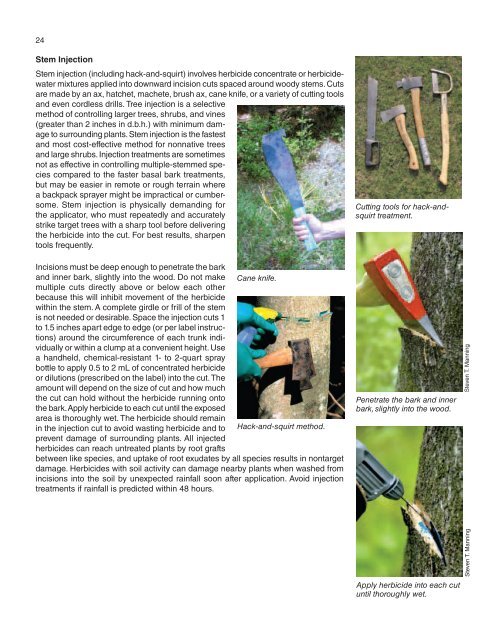24Stem InjectionStem <strong>in</strong>jection (<strong>in</strong>clud<strong>in</strong>g hack-and-squirt) <strong>in</strong>volves herbicide concentrate or herbicidewatermixtures applied <strong>in</strong>to downward <strong>in</strong>cision cuts spaced around woody stems. Cutsare made by an ax, hatchet, machete, brush ax, cane knife, or a variety of cutt<strong>in</strong>g toolsand even cordless drills. Tree <strong>in</strong>jection is a selectivemethod of controll<strong>in</strong>g larger trees, shrubs, and v<strong>in</strong>es(greater than 2 <strong>in</strong>ches <strong>in</strong> d.b.h.) with m<strong>in</strong>imum damageto surround<strong>in</strong>g plants. Stem <strong>in</strong>jection is the fastestand most cost-effective method <strong>for</strong> nonnative treesand large shrubs. Injection treatments are sometimesnot as effective <strong>in</strong> controll<strong>in</strong>g multiple-stemmed speciescompared to the faster basal bark treatments,but may be easier <strong>in</strong> remote or rough terra<strong>in</strong> wherea backpack sprayer might be impractical or cumbersome.Stem <strong>in</strong>jection is physically demand<strong>in</strong>g <strong>for</strong>the applicator, who must repeatedly and accuratelystrike target trees with a sharp tool be<strong>for</strong>e deliver<strong>in</strong>gthe herbicide <strong>in</strong>to the cut. For best results, sharpentools frequently.Incisions must be deep enough to penetrate the barkand <strong>in</strong>ner bark, slightly <strong>in</strong>to the wood. Do not make Cane knife.multiple cuts directly above or below each otherbecause this will <strong>in</strong>hibit movement of the herbicidewith<strong>in</strong> the stem. A complete girdle or frill of the stemis not needed or desirable. Space the <strong>in</strong>jection cuts 1to 1.5 <strong>in</strong>ches apart edge to edge (or per label <strong>in</strong>structions)around the circumference of each trunk <strong>in</strong>dividuallyor with<strong>in</strong> a clump at a convenient height. Usea handheld, chemical-resistant 1- to 2-quart spraybottle to apply 0.5 to 2 mL of concentrated herbicideor dilutions (prescribed on the label) <strong>in</strong>to the cut. Theamount will depend on the size of cut and how muchthe cut can hold without the herbicide runn<strong>in</strong>g ontothe bark. Apply herbicide to each cut until the exposedarea is thoroughly wet. The herbicide should rema<strong>in</strong><strong>in</strong> the <strong>in</strong>jection cut to avoid wast<strong>in</strong>g herbicide and to Hack-and-squirt method.prevent damage of surround<strong>in</strong>g plants. All <strong>in</strong>jectedherbicides can reach untreated plants by root graftsbetween like species, and uptake of root exudates by all species results <strong>in</strong> nontargetdamage. Herbicides with soil activity can damage nearby plants when washed from<strong>in</strong>cisions <strong>in</strong>to the soil by unexpected ra<strong>in</strong>fall soon after application. Avoid <strong>in</strong>jectiontreatments if ra<strong>in</strong>fall is predicted with<strong>in</strong> 48 hours.Cutt<strong>in</strong>g tools <strong>for</strong> hack-andsquirttreatment.Penetrate the bark and <strong>in</strong>nerbark, slightly <strong>in</strong>to the wood.Steven T. Mann<strong>in</strong>gApply herbicide <strong>in</strong>to each cutuntil thoroughly wet.Steven T. Mann<strong>in</strong>g
25Special tree <strong>in</strong>jectors are available that comb<strong>in</strong>e the cutt<strong>in</strong>g operation with automatedherbicide delivery. For <strong>in</strong>ject<strong>in</strong>g some herbicides (am<strong>in</strong>e <strong>for</strong>mulations), the Hypo-Hatchet ® Tree <strong>in</strong>jector (Forestry Suppliers Inc., 800–647–5368, www.<strong>for</strong>estry-suppliers.com)consists of a steel hatchet connected to a herbicide conta<strong>in</strong>er (worn on belt)by tub<strong>in</strong>g. The <strong>in</strong>jector delivers a set amount of herbicide <strong>in</strong>to the cut. Daily clean<strong>in</strong>gand lubrication of the impact piston is required ma<strong>in</strong>tenance, along with periodicreplacement of rubber o-r<strong>in</strong>gs and seals. Check all hoses and fitt<strong>in</strong>gs be<strong>for</strong>e use <strong>for</strong>leaks and make appropriate repairs to prevent accidental exposure of herbicide to theapplicator. When work<strong>in</strong>g with the Hypo-Hatchet <strong>in</strong> dense <strong>in</strong>festations, be m<strong>in</strong>dful ofthe supply tub<strong>in</strong>g, which might become tangled and easily disconnected.Another <strong>in</strong>jector is the EZ-Ject ® , which consists of a steel lance that holds 400 shellsof glyphosate or imazapyr herbicides (ArborSystems, 888–395–6732, www.ezject.com). The head of the lance is placed aga<strong>in</strong>st the base of the target woody plant,and a manual thrust jams the shell through the bark <strong>in</strong>to the <strong>in</strong>ner bark. As with other<strong>in</strong>jection methods, these shells are spaced around each stem. The EZ-Ject is themost efficient and effective <strong>in</strong>jection option <strong>for</strong> treat<strong>in</strong>g multi-stemmed, low-branch<strong>in</strong>gshrubs like privets, silverthorn (Elaeagnus pungens Thunb.), and bush honeysuckles(Lonicera spp.), as well as large entangled v<strong>in</strong>es like oriental bittersweet (Celastrusorbiculatus Thunb.). Shell jamm<strong>in</strong>g has been reported as a problem when us<strong>in</strong>g theEZ-Ject to treat extensive <strong>in</strong>festations. Remov<strong>in</strong>g the herbicide shells when not <strong>in</strong>use, proper use, and daily ma<strong>in</strong>tenance can help prevent jamm<strong>in</strong>g.Tree <strong>in</strong>jection can be applied at most times throughout the year, but December tothe middle of January seems to be least effective <strong>in</strong> the Midsouth. Prolonged coldtemperatures can freeze herbicide <strong>in</strong> the cut, result<strong>in</strong>g <strong>in</strong> poor absorption. Heavyspr<strong>in</strong>g sapflow can wash herbicide from <strong>in</strong>cision cuts, result<strong>in</strong>g <strong>in</strong> poor control andsoil transfer to nontarget plants. Prolonged andsevere drought is also an <strong>in</strong>effective period.Hypo Hatchet® Tree Injector.EZ-Ject® tree <strong>in</strong>jector.Steven T. Mann<strong>in</strong>gCut-TreatCut-treat <strong>in</strong>volves apply<strong>in</strong>g herbicide concentrates,herbicide-water or herbicide-penetrantmixtures to the outer circumference of freshlycut stumps or the entire top surface of cutstems. Applications are made with a spraybottle, backpack sprayer, wick, or pa<strong>in</strong>t brush.Freshly cut stems and stumps of trees, woodyv<strong>in</strong>es, shrubs, canes, and bamboo stems canbe treated with herbicide mixtures to preventresprout<strong>in</strong>g and to kill roots. It is critical that thecut is made as low as possible to the ground,and that the stem is treated immediately afterthe cut is made. <strong>Invasive</strong>s not treated withherbicides after cutt<strong>in</strong>g <strong>in</strong>variably resprout and<strong>in</strong>tensify their <strong>in</strong>festation. Cutt<strong>in</strong>g is usually bycha<strong>in</strong>saw or brush saw but can be made byhandsaws and cutt<strong>in</strong>g blades.Cut-treat the circumference of large stems, and the entire top ofsmall stems.A 2-quart pressuredspray bottle works well<strong>for</strong> stump treatment.Steven T. Mann<strong>in</strong>gCut stems low <strong>for</strong> treat<strong>in</strong>g.Steven T. Mann<strong>in</strong>g
















